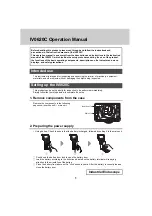
Remote Control
R&S
®
ZNC
349
User Manual 1173.9557.02 ─ 13
The analyzer implements
INITiate[:IMMediate]...
commands as overlapped
commands. Assuming e.g. that
INITiate[:IMMediate][:DUMMy]
takes longer to
execute than
*OPC
, sending the command sequence
INIT; *OPC.
results in initiating a sweep and, after some time, setting the OPC bit in the ESR. Sending
the commands:
INIT; *OPC; *CLS
still initiates a sweep. Since the operation is still pending when the analyzer executes
*CLS, forcing it into the Operation Complete Command Idle State (OCIS), *OPC is effec-
tively skipped. The OPC bit is not set until the analyzer executes another *OPC command.
The analyzer provides only two overlapped commands,
INITiate<Ch>[:IMMediate][:DUMMy]
and
INITiate<Ch>[:IMMediate]:ALL
.
What is said below is not relevant for the other (sequential) SCPI commands.
Preventing overlapping execution
To prevent an overlapping execution of commands, one of the commands
*OPC
,
*OPC?
or
*WAI
can be used. For a programming example refer to
of the Measurement and Command Synchronization"
Command
Action after the hardware has settled
Programming the controller
*WAI
Stops further command processing until all commands
sent before
*WAI
have been executed
Note: The GPIB bus handshake is not stopped
Send
*WAI
directly after the command which should
be terminated before the next command is executed.
*OPC?
Stops command processing until 1 is returned, i.e. until
the "Operation Complete" bit has been set in the ESR.
This bit indicates that the previous commands have been
completed.
Send
*OPC?
directly after the command which
should be terminated before the next command is
executed.
*OPC
Sets the operation complete bit in the ESR after all pre-
vious commands have been executed.
– Set bit 0 in the ESE
– Set bit 5 in the SRE
– Wait for service request (SRQ)
5.5 Status Reporting System
The status reporting system stores all information on the present operating state of the
instrument, and on errors which have occurred. This information is stored in the status
registers and in the error queue. Both can be queried using the
STATus...
commands.
Hierarchy of status registers
As shown in section
, the status information is of hierarchical
structure.
Status Reporting System
















































